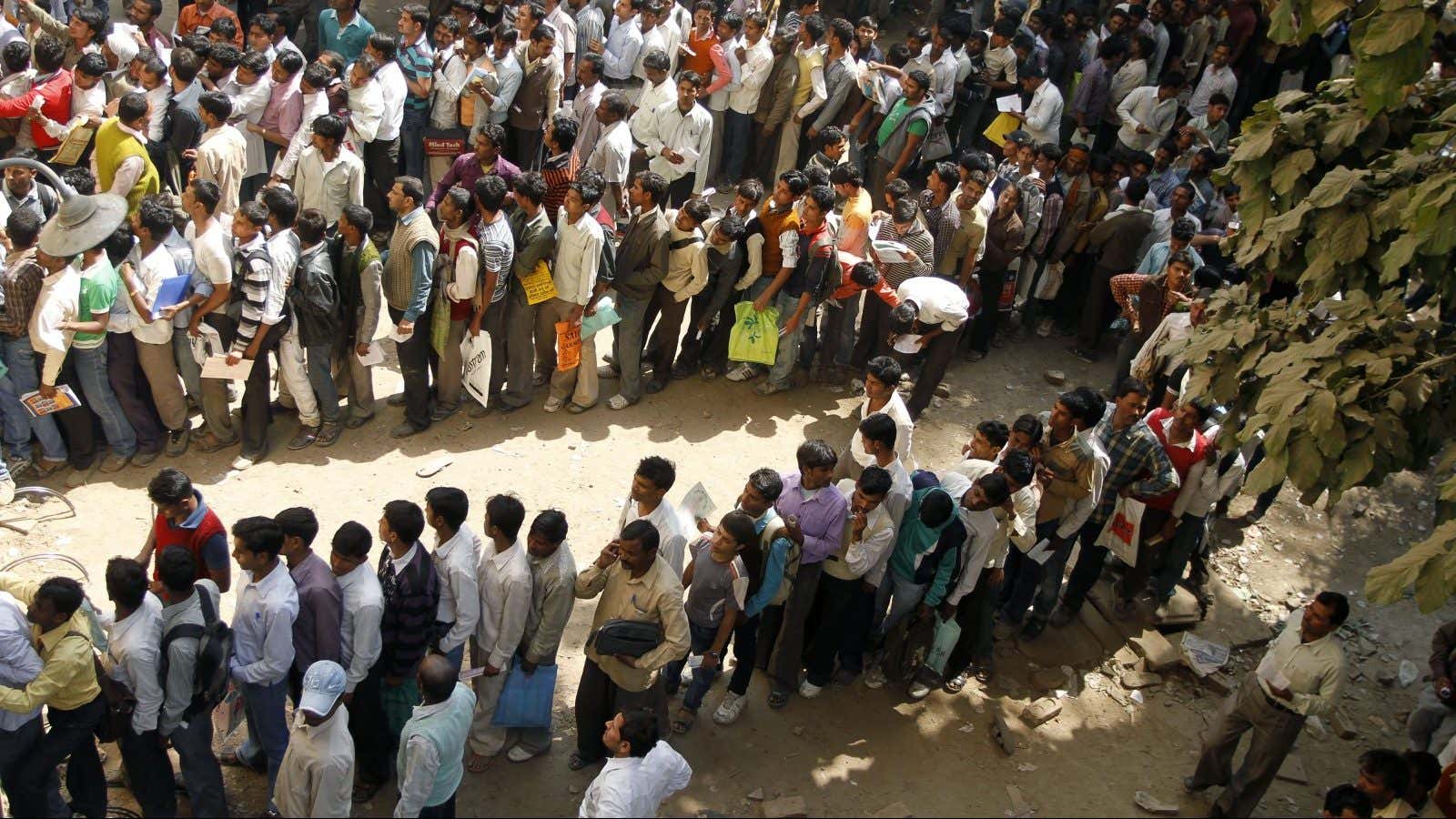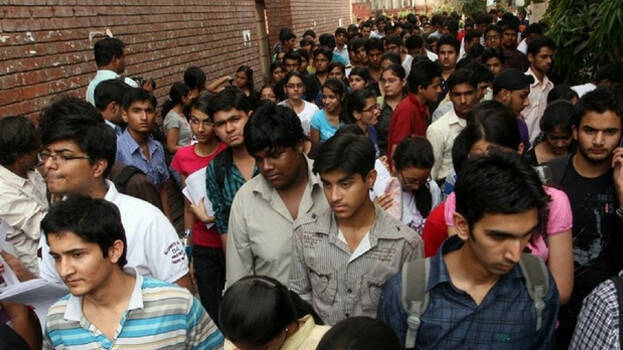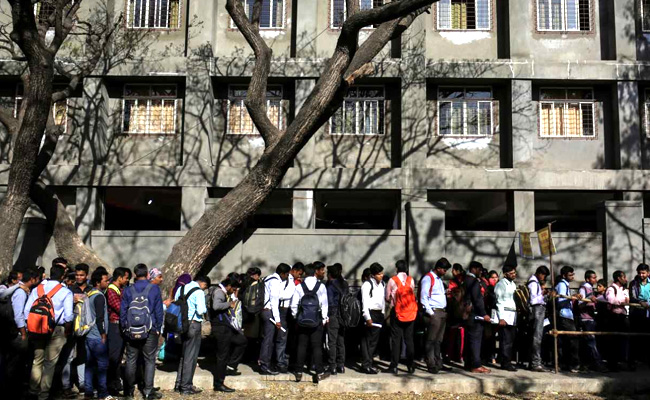In the din of economic statistics and projections, one figure stands out sharply – India’s unemployment rate surged to 10.05% in October, the highest in over two years.
The alarming spike, reported by the Centre for Monitoring Indian Economy, sends ripples of concern through the nation’s socio-economic fabric.
It prompts us to ponder not just the numbers, but the deeper questions they raise about the trajectory of our nation’s growth and the opportunities it affords to its citizens.
At the heart of this crisis lies a conundrum – where are the jobs?
The traditional engines of India’s growth, particularly the IT sector and once flourishing startups, are sputtering. Even the once-reliable bastions of employment, the prestigious IITs and IIMs, are witnessing their graduates grappling for placements in an increasingly competitive market.
Hence, where will the avenues of opportunity emerge in a country with such immense human capital?
Some argue that economic growth can be measured by government spending and borrowing. Yet, can real progress be defined solely by fiscal metrics, or should it be measured by the creation of meaningful employment opportunities that enhance the productivity and well-being of the populace?

The Unemployment Crises
Looking deeper into the data, the plight of rural India emerges as a distressing reality; with the weakest monsoon in five years crippling agricultural prospects, rural unemployment has soared to alarming levels.
This paints a picture of desperation and deprivation in the very heartlands of our country, where livelihoods have long been intertwined with the rhythms of the land.
In contrast, urban areas present a mixed narrative. While manufacturing and consumption have buoyed employment prospects to some extent, the specter of joblessness still looms large, casting a shadow over the aspirations of millions who flock to cities in search of a better life.
The reliance on private think tanks for unemployment data indicates a troubling gap in official statistics.
As economists and policymakers grapple with the magnitude of the crisis, the need for robust, transparent data becomes increasingly apparent. The dichotomy between official dismissals and the ground realities faced by millions only serves to deepen the sense of disillusionment among the populace.

The Reality
The State of Working India 2023 report paints a nuanced picture of the challenges ahead. While overall unemployment rates may have dipped marginally post-COVID, the possibility of joblessness continues to haunt young graduates, with a staggering 42% facing unemployment.
This raises deep questions about the alignment of education with employment and the mismatch between skills and opportunities in the job market.
Job creation must be elevated to the forefront of our economic agenda, with a focus on facilitating inclusive growth that leaves no segment of society behind.
Ten-Year Record on Employment; Does the Reality Match the Promises or Claims?
As the tenure of the current regime draws to a close, it’s a time to reflect on the promises made and the realities faced in the employment arena.
Back in 2014, amidst a wave of optimism, ambitious targets were set – two core jobs per year, a promise that held the potential to transform the socio-economic landscape of the nation.
Yet, as we approach March 2024, the glaring question remains – have these promises borne fruit, or have they wilted in the face of harsh realities?
A cursory glance at the data paints a bleak picture.
The reversal of employment growth in the non-farm sector and the stagnation in initiatives like Skill India raise red flags about the efficacy of the policies touted as panaceas for unemployment woes.
The reality is sharp – open unemployment, a mere 2.1% in 2012, ballooned to 6.1% by 2018, marking the highest rate in 45 years of India’s labor force surveys.
The total number of unemployed individuals tripled from one crore in 2012 to three crore in 2018, with youth bearing the brunt of the crisis. The unemployment rates for various educational cohorts paint a grim picture, with graduates and post-graduates facing alarmingly high rates of joblessness.
The conundrum deepens with the paradox of higher education enrollment targets juxtaposed against rising unemployment among graduates.
The New Education Policy 2020’s lofty goal of doubling higher education enrollment to 50% by 2035 appears increasingly untenable against the backdrop of dwindling employment prospects for the current crop of graduates.
)
More Data – Higher Education But No Jobs To Match
The India Skills Report 2021 delivers another blow, revealing that nearly half of India’s graduates are deemed unemployable, accentuating the precipitous decline in education quality over the past two decades.
The proliferation of private colleges, bereft of adequate regulation and oversight, further aggravates the crisis, with quality education remaining elusive for many.
Skill India, heralded as a harbinger of change, falls short of its promises. Despite ambitious targets, the share of vocationally trained workers remains stagnant, failing to make a dent in the unemployment quagmire.
The lackluster outcomes of schemes like the Pradhan Mantri Kaushal Vikas Yojana underscore the glaring gap between rhetoric and reality.
Yet, amidst these sobering statistics, the political terrain offers a perplexing paradox.
Despite mounting discontent over rising unemployment, the share of youth voting for the ruling party surged in the 2019 Lok Sabha elections.
How do we reconcile this apparent contradiction?
Perhaps it’s an example of the art of political manoeuvring, where nationalistic fervour eclipses the discomfort of joblessness, at least temporarily.
As we go further into the labyrinth of statistics and political rhetoric, one thing remains abundantly clear – the unemployment crisis in India is not just a statistical anomaly but a harsh reality that demands urgent attention.
.jpeg)
A Deepening Crisis; The Unemployment Quagmire
The past decade has witnessed a deepening crisis in employment, affecting three significant groups within India’s workforce.
As the number of individuals seeking non-farm jobs continues to grow, we face both a high stock of unemployment and a rising influx of job seekers each month.
This stockpile is further compounded by the addition of several hundred thousand job seekers each month, exacerbating the unemployment conundrum.
Secondly, there is a constant flow of young people entering the workforce, numbering at least eight million annually.
The pressure to find gainful employment intensifies as the share of the working-age population rises, particularly among young girls whose educational levels have surged in recent decades.
Thirdly, a substantial segment of the workforce remains underemployed in agriculture, constituting 46% of the workforce in 2023 despite contributing only 15% to India’s GDP.
The shrinking size of farm plots, coupled with stagnant productivity and low incomes, has spurred migration to non-farm livelihoods, adding to the burden of unemployment.
Tragically, government policies since 2016 have failed to address the dearth of non-farm job creation, exacerbating the crisis. The sudden imposition of a stringent nationwide lockdown in April 2020 forced millions to migrate back to rural areas, further straining the agricultural sector.
Compounding the issue is the reversal of structural change, with the share of agriculture in GDP rising and the absolute number of farm workers increasing.
This stands in sharp contrast to the promises of increasing employment in manufacturing and bolstering its contribution to GDP, which have remained unfulfilled.

The collapse of labour-intensive manufacturing, coupled with a slowdown in economic growth, has perpetuated the employment crisis.
Despite government efforts to spin narratives of job growth, the reality remains grim, with real wages stagnating and investment levels failing to recover to pre-2014 levels.
Efforts to downplay the severity of the crisis, whether by disputing CMIE data or citing EPFO registrations, only serve to obfuscate the underlying issues.
The lack of concerted action to address the structural deficiencies in the economy leaves us facing a ‘lost decade’ of jobs, with little time remaining to harness the demographic dividend.
The Last Bit, the unemployment quagmire in India demands urgent attention and bold policy interventions to reverse the tide of joblessness and unlock the country’s true economic potential.
In the final analysis, the unemployment crisis in India is not just a statistical anomaly but a looming crisis of great proportions.
The structural inequalities and systemic failures underpin it, and to forge a path towards a future where every Indian has the opportunity to realize their fullest potential; only and only then can we truly claim to be a country on the path to prosperity and progress.
